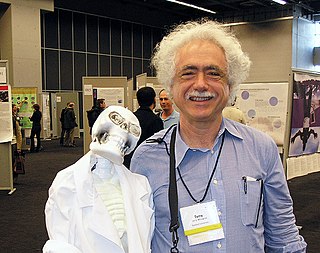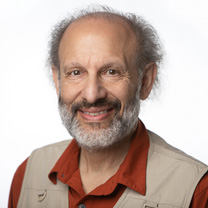
Terry Allen Winograd is an American professor of computer science at Stanford University, and co-director of the Stanford Human–Computer Interaction Group. He is known within the philosophy of mind and artificial intelligence fields for his work on natural language using the SHRDLU program.
Social computing is an area of computer science that is concerned with the intersection of social behavior and computational systems. It is based on creating or recreating social conventions and social contexts through the use of software and technology. Thus, blogs, email, instant messaging, social network services, wikis, social bookmarking and other instances of what is often called social software illustrate ideas from social computing.

Vaughan Pratt is a Professor Emeritus at Stanford University, who was an early pioneer in the field of computer science. Since 1969, Pratt has made several contributions to foundational areas such as search algorithms, sorting algorithms, and primality testing. More recently, his research has focused on formal modeling of concurrent systems and Chu spaces.
Personalization consists of tailoring a service or product to accommodate specific individuals, sometimes tied to groups or segments of individuals. Personalization requires collecting data on individuals, including web browsing history, web cookies, and location. Companies and organizations use personalization to improve customer satisfaction, digital sales conversion, marketing results, branding, and improved website metrics as well as for advertising. Personalization is a key element in social media and recommender systems. Personalization affects every sector of society—work, leisure, and citizenship.
Microsoft Research (MSR) is the research subsidiary of Microsoft. It was created in 1991 by Richard Rashid, Bill Gates and Nathan Myhrvold with the intent to advance state-of-the-art computing and solve difficult world problems through technological innovation in collaboration with academic, government, and industry researchers. The Microsoft Research team has more than 1,000 computer scientists, physicists, engineers, and mathematicians, including Turing Award winners, Fields Medal winners, MacArthur Fellows, and Dijkstra Prize winners.

Mark S. Miller is an American computer scientist. He is known for his work as one of the participants in the 1979 hypertext project known as Project Xanadu; for inventing Miller columns; and the open-source coordinator of the E programming language. He also designed the Caja compiler. Miller is a Senior Research Fellow at the Foresight Institute.
Google Personalized Search is a personalized search feature of Google Search, introduced in 2004. All searches on Google Search are associated with a browser cookie record. When a user performs a search, the search results are not only based on the relevance of each web page to the search term, but also on which websites the user visited through previous search results. This provides a more personalized experience that can increase the relevance of the search results for the particular user. Such filtering may also have side effects, such as the creation of a filter bubble.
EigenTrust algorithm is a reputation management algorithm for peer-to-peer networks, developed by Sep Kamvar, Mario Schlosser, and Hector Garcia-Molina. The algorithm provides each peer in the network a unique global trust value based on the peer's history of uploads and thus aims to reduce the number of inauthentic files in a P2P network. It has been cited by approximately 3853 other articles according to Google Scholar.

The following outline is provided as an overview of and topical guide to artificial intelligence:
Social search is a behavior of retrieving and searching on a social searching engine that mainly searches user-generated content such as news, videos and images related search queries on social media like Facebook, LinkedIn, Twitter, Instagram and Flickr. It is an enhanced version of web search that combines traditional algorithms. The idea behind social search is that instead of ranking search results purely based on semantic relevance between a query and the results, a social search system also takes into account social relationships between the results and the searcher. The social relationships could be in various forms. For example, in LinkedIn people search engine, the social relationships include social connections between searcher and each result, whether or not they are in the same industries, work for the same companies, belong the same social groups, and go the same schools, etc.

Alex Paul "Sandy" Pentland is an American computer scientist, the Toshiba Professor of Media Arts and Sciences at MIT, and serial entrepreneur.
Kaltix Corporation was a personalized search engine company founded at Stanford University in June 2003 by Sepandar Kamvar, Taher Haveliwala, and Glen Jeh. It was acquired by Google in September 2003.

Jonathan Jennings Harris is an American artist and computer scientist, known for his work with data visualization, interactive documentary, and ritual.

Andrew Yan-Tak Ng is a British-American computer scientist and technology entrepreneur focusing on machine learning and artificial intelligence (AI). Ng was a cofounder and head of Google Brain and was the former Chief Scientist at Baidu, building the company's Artificial Intelligence Group into a team of several thousand people.
Computational journalism can be defined as the application of computation to the activities of journalism such as information gathering, organization, sensemaking, communication and dissemination of news information, while upholding values of journalism such as accuracy and verifiability. The field draws on technical aspects of computer science including artificial intelligence, content analysis, visualization, personalization and recommender systems as well as aspects of social computing and information science.

PageRank (PR) is an algorithm used by Google Search to rank web pages in their search engine results. It is named after both the term "web page" and co-founder Larry Page. PageRank is a way of measuring the importance of website pages. According to Google:
PageRank works by counting the number and quality of links to a page to determine a rough estimate of how important the website is. The underlying assumption is that more important websites are likely to receive more links from other websites.

A filter bubble or ideological frame is a state of intellectual isolation that can result from personalized searches, recommendation systems, and algorithmic curation. The search results are based on information about the user, such as their location, past click-behavior, and search history. Consequently, users become separated from information that disagrees with their viewpoints, effectively isolating them in their own cultural or ideological bubbles, resulting in a limited and customized view of the world. The choices made by these algorithms are only sometimes transparent. Prime examples include Google Personalized Search results and Facebook's personalized news-stream.
We Feel Fine is an interactive website, artwork, and book created by Jonathan Harris and Sep Kamvar that searches the internet every 10 minutes for expressions of human emotion on blogs and then displays the results in several visually-rich dynamic representations. Created in 2005 and launched in 2006, We Feel Fine was turned into a book in 2009.

Jacob O. Wobbrock is a Professor in the University of Washington Information School and, by courtesy, in the Paul G. Allen School of Computer Science & Engineering at the University of Washington. He is Director of the ACE Lab, Associate Director and founding Co-Director Emeritus of the CREATE research center, and a founding member of the DUB Group and the MHCI+D degree program.

Ashish Goel is an American professor whose research focuses on the design, analysis and applications of algorithms. He is a professor of Management Science and Engineering at Stanford University.











